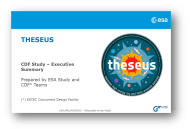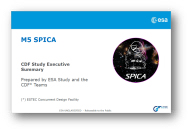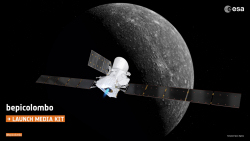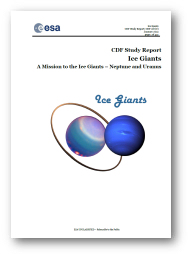ESA Science & Technology - Publication Archive
Publication archive
Publication archive
Document reference: CDF-187(C)
A mission to the Ice Giants (Neptune and Uranus) will be among the ones examined by the next Planetary Sciences Decadal, which also fits with the potential launch opportunity, with a Jupiter swing-by, that would allow to reach both planets by launching in the early 2030s.
ESA is exploring potential contributions to a NASA-led mission to the ice giants aimed at understanding the interior structure and bulk composition of the planet(s), including isotopes and noble gases.
ESA and NASA agreed to study a palette of possible configurations of varying cost to ESA and complexity, keeping in mind the need for clear interfaces.
It is important to keep this background in mind and remember that this study is not analysing a specific science proposal but trying to understand potential contributions following a top-down approach.
Requested by SCI-FM and funded by GSP, the M* (Ice Giants) study was set to analyse the feasibility of "stand-alone" elements provided by ESA to be part of the NASA-led mission to Uranus, Neptune and their moons (M-class mission budget but not proposed following a Cosmic Vision Programme Call, hence M*).
 |
The internal Phase 0 study of the M5 mission candidate THESEUS has been performed at ESA's Concurrent Design Facility (CDF) between June and November 2018. An internal final presentation has been prepared by the CDF Team, summarizing the outcome of the Phase 0 study. This presentation can be downloaded as a PDF (10 MB) by clicking the image to the right, or the 'link to publication' link below.
The internal final presentations of the internal Phase 0 studies of the other two M5 mission candidates, EnVision and SPICA, are also available.
 |
The internal Phase 0 study of the M5 mission candidate SPICA has been performed at ESA's Concurrent Design Facility (CDF) between June and November 2018. An internal final presentation has been prepared by the CDF Team, summarizing the outcome of the Phase 0 study. This presentation can be downloaded as a PDF (6 MB) by clicking the image to the right, or the 'link to publication' link below.
The internal final presentations of the internal Phase 0 studies of the other two M5 mission candidates, EnVision and THESEUS, are also available.
 |
The internal Phase 0 study of the M5 mission candidate EnVision has been performed at ESA's Concurrent Design Facility (CDF) between June and November 2018. An internal final presentation has been prepared by the CDF Team, summarizing the outcome of the Phase 0 study. This presentation can be downloaded as a PDF (10 MB) by clicking the image to the right, or the 'link to publication' link below.
The internal final presentations of the internal Phase 0 studies of the other two M5 mission candidates, SPICA and THESEUS, are also available.
Reference: Branduardi-Raymont, G., C. Wang, C.P. Escoubet, et al., SMILE definition study report, European Space Agency, ESA/SCI, 1, 2018
Full citation: Branduardi-Raymont, G., C. Wang, C.P. Escoubet, M. Adamovic, D. Agnolon, M. Berthomier, J.A. Carter, W. Chen, L. Colangeli, M. Collier, H.K. Connor, L. Dai, A. Dimmock, O. Djazovski, E. Donovan, J.P. Eastwood, G. Enno, F. Giannini, L. Huang, D. Kataria, K. Kuntz, H. Laakso, J. Li, L. Li, T. Lui, J. Loicq, A. Masson, J. Manuel, A. Parmar, T. Piekutowski, A.M. Read, A. Samsonov, S. Sembay, W. Raab, C. Ruciman, J.K. Shi, D.G. Sibeck, E.L. Spanswick, T. Sun, K. Symonds, J. Tong, B. Walsh, F. Wei, D. Zhao, J. Zheng, X. Zhu, Z. Zhu, SMILE definition study report, European Space Agency, ESA/SCI, 1, 2018
DOI: https://doi.org/10.5270/esa.smile.definition_study_report-2018-12
SMILE (Solar wind Magnetosphere Ionosphere Link Explorer) was selected from a pool of 13 potential missions that were proposed to the European Space Agency (ESA) and the Chinese Academy of Sciences (CAS) as a result of a joint call for mission concepts in June 2015.
Following its selection in November 2015, detailed studies were performed by ESA, CAS, three European industrial contractors and the Science Study Team to finalise the mission architecture, including the space and ground elements that are required to fulfil the science requirements. This report, also known as the Red Book, summarizes the SMILE definition study.
 |
Download this interactive media kit to learn more about the launch of BepiColombo on 20 October 2018, the spacecraft's seven year journey to Mercury, and the science goals of the mission.
Contents:
Introduction
Event Programme
Key messages
BepiColombo science themes
From Messenger to BepiColombo
Mercury Planetary Orbiter's science instruments
Mercury Magnetospheric Orbiter's science instruments
Launch and separation timeline
Mercury Transfer Module cameras
Journey to Mercury
Venus flyby science operations
Arrival at Mercury
Operating in extreme environments
Quick look Mercury facts
Principal investigators
Selected images
Selected videos
Media services
Update 10 October 2018: Updated figure on pages 8 and 12.
Update 18 October 2018: Inserted new page 11 (MTM cameras), updated figure on pages 8, 9, 13 and 16, changed "MMO-MAG" to "MMO-MGF" throughout, added link to cartoon video, changed email address for University of Leicester contact (page 22).
Update 08 April 2020: A new version was released containing an updated version of the journey graphic on p12.
To download the pdf file (14 MB) click on the image or on the link to publication below.
Open access: This article is licensed under a Creative Commons Attribution 4.0 International License, which permits use, sharing, adaptation, distribution and reproduction in any medium or format, as long as you give appropriate credit to the original author(s) and the source, provide a link to the Creative Commons license, and indicate if changes were made. The images or other third party material in this article are included in the article's Creative Commons license, unless indicated otherwise in a credit line to the material. If material is not included in the article's Creative Commons license and your intended use is not permitted by statutory regulation or exceeds the permitted use, you will need to obtain permission directly from the copyright holder.

